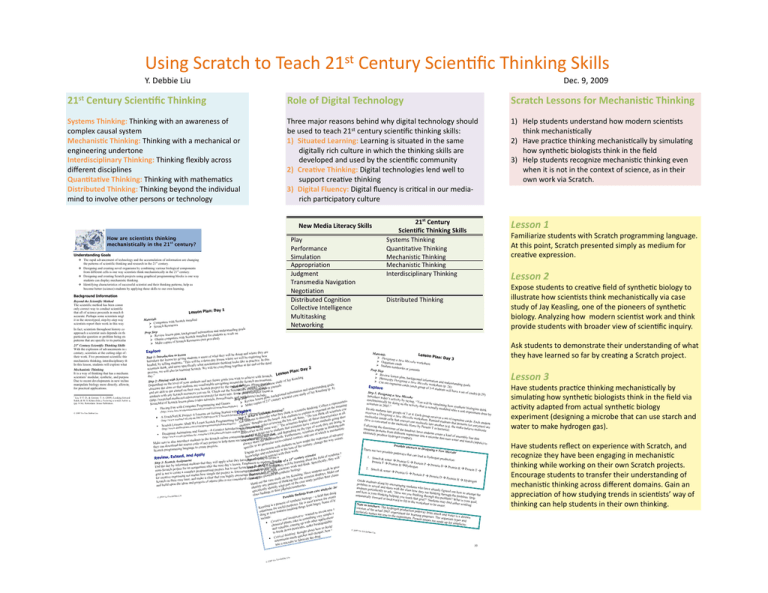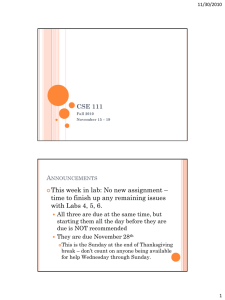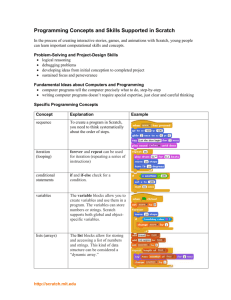Document 13438246
advertisement

Using Scratch to Teach 21st Century Scien5fic Thinking Skills Y. Debbie Liu Dec. 9, 2009 21st Century Scien/fic Thinking Role of Digital Technology Scratch Lessons for Mechanis/c Thinking Systems Thinking: Thinking with an awareness of complex causal system Mechanis/c Thinking: Thinking with a mechanical or engineering undertone Interdisciplinary Thinking: Thinking flexibly across different disciplines Quan/ta/ve Thinking: Thinking with mathema5cs Distributed Thinking: Thinking beyond the individual mind to involve other persons or technology Three major reasons behind why digital technology should be used to teach 21st century scien5fic thinking skills: 1) Situated Learning: Learning is situated in the same digitally rich culture in which the thinking skills are developed and used by the scien5fic community 2) Crea/ve Thinking: Digital technologies lend well to support crea5ve thinking 3) Digital Fluency: Digital fluency is cri5cal in our media-­‐ rich par5cipatory culture 1) Help students understand how modern scien5sts think mechanis5cally 2) Have prac5ce thinking mechanis5cally by simula5ng how synthe5c biologists think in the field 3) Help students recognize mechanis5c thinking even when it is not in the context of science, as in their own work via Scratch. !"#$%"&'($)'*"+(,-$./'001$ !"#$%% !&'()'*#+,&% -.*/"#0.)+% 9::'):'.#0.)+% ;/<5*&+0%% 2'#+1*&<.#%=#7.5#0.)+% =&5)0.#0.)+% ?.10'.@/0&<%A)5+.0.)+% A)""&,0.7&%>+0&"".5&+,&% 8/"0.0#14.+5%% =&0B)'4.+5% How are scientists thinking mechanistically in the 21st century? Photo courtesy: http://syntheticbiology.org/ Understanding Goals ! The rapid advancement of technology and the accumulation of information are changing the patterns of scientific thinking and research in the 21st century. ! Designing and creating novel organisms by combining various biological components from different cells is one way scientists think mechanistically in the 21st century. ! Designing and creating Scratch projects using graphical programming blocks is one way students can display mechanistic thinking. ! Identifying characteristics of successful scientist and their thinking patterns, help us become better (science) students by applying these skills to our own learning. Background Information 231*$4"5*6+-$$ .,'"5*'7',$89'5/'5:$./'001$ -$10&*1%23.+4.+5%% 6/#+0.0#0.7&%23.+4.+5%% 8&,3#+.10.,%23.+4.+5% 8&,3#+.10.,%23.+4.+5% >+0&'<.1,.:".+#'$%23.+4.+5% ?.10'.@/0&<%23.+4.+5% Beyond the Scientific Method The scientific method has been commonly taught in science classrooms and textbooks as the only correct way to conduct scientific investigations. This leaves students with the impression Day 1 that all of science proceeds in much the same way. Unfortunately, this view is not entirely Lesson Plan: accurate. Perhaps some scientists might conduct their work in this manner, but rarely do they use rials it—despite the fact Mate it in the stereotyped, step-by-step way that schools tend to teach installed Scratchthat ! Computers with scientists report their work in this way in journals. es ! Scratch Resourc ls In fact, scientists throughout history conduct their research in a variety of ways. The exact understanding goa Prep approach a scientist uses depends on the individual doing theStep investigation as well as the und information and lesson plan, backgro h installed for students to work on Reviewoften particular question or problem being studied. Furthermore,!scientists engage in thinking uters with Scratc comp in Obta ! es (not provided) patterns that are specific to its particular socio-cultural context s of Scratch Resourc copie Make ! 21st Century Scientific Thinking Skills With the explosion of advancements in scientific knowledge and technology at the turn of the lore Expto e they are century, scientists at the cutting edge of research must adapt new ways of interacting with Materials be doing and wher Lesson Pla lesson st oduction of what they will their work. Five prominent scientific thinking patterns ofSte the 21Intr century are: to systems thinking, xploring how p 1: n: Day 3 ! Designi students1 a sense here we will be e by givingthinking ng sondistributed e the les mechanistic thinking, interdisciplinary thinking, quantitative thinking, and . a three-day lesson w looks like in practice. In this be ! Organism a New Microbe work Introduc sheet students, “This will tic thinking third cards In this lesson, students will explore what mechanistic thinking. ! Studen headed, by telling y what mechanis r at the end of the he ficall toget speci hing t t more not nd ebooks or j tie every 2 scientists think, a ournals Scratch. We will ay ing Mechanistic Thinking Pr D ep learn be S lso tep a ss, we will proce n Plan: It is a way of thinking that has a mechanical or engineering undertone. This is shown through ! Review Lesso lesson plan, day.” scientists’ modular, synthetic, and purpose-driven approach towards their research problems. ve with Scratch, ! Photoc ch you wish to achie opy Design background informati Keasling ng with Due to recent developments in new technologies and knowledge, scientists are Scrat able to students and any future goals ing ch environment, study of Jay on ! Cut out Step 2: Playi around the Scrat of your organism card a New Microbe work and understanding goa he level t case on tnovel e provi ls manipulate biology more directly, allowing them to engineer and create biological nts systems tisde nding fortable navigating Pleas a s shee l ls com Depe en lass. i c go s (each gro are ia the als sc of er ng di the end Explore st century earch or journ so that stude up of 3-4 stud t (p. 28) Mat eesbooks for practical applications. derstan g (p. 8) Scratch project by sourc re structure the class 21 un own d's ents will ha ir hE c the nd ! t on a lin the Scrat no t started ve a set of y Keas mation udeent Step 1: Des see fit. Check out xamples found in Ja or St and are able to ge cards) (p.2 you good nf e of i rces ! Som resou h dy igning a Ne c info. 9) : background st case stu ts with any Scrat w Microbe Introduce t es/search) for more ts, and worksheets) include uden 1 ourc i s n, nt a du/re Liu, Y-T. D., & Grotzer, T. A. (2009). Looking forward: Teaching the naturestof the science of today and tomorrow. In I. M. .e oda pl .mit y’s act n erPoin Prep Step .media y scie tched //scra deo tutorials, Pow Saleh, & M. S. Khine (Eds.), Fostering scientific habits of mind: Pedagogical(http: knowledge and best practices in science education ew lesso of 21st centur e list of at mechanistically by ivity by saying, “You ch lesson plans (vi ! Revi will be sim doing an the sentativ ies (pp. 9-36). Rotterdam: Sense Publishers. scientists in ScratchEd of Scrat ul a repre ning behind wh ing and Games ns/) ! Make cop at ac i ct ng ti amm vit 200 how Progr lle y that is act 7.” synthetic bio onpla with Computer their ually mode ing. Co on the mea level/scratchless to nk l ogi e second hi D t • Having Fun st ivi reach/ s led c om de t nd hi after a real nk students int ou ts c /educationout ntifi ing? It is Scrat experimen ore emeofworkn.htitm o gro (http://www.lero.ie d withEx plch cl) think y think is scie explain or exp ink all scientis all times?” receives a © 2009 Yu-Tzu Debbie Liu t done by 8_sch 1 ns on Getting Starte Designing ups of 3 or 4. Each gro at cie fi ratch/Scratch/pages/ : What is s a New Mic K Project: 6 Lesso what the k students to , “ Do you th aracteristics out their up receives molecules robe m • A TeachNetU net-uk.org.uk/2007%20Projects/ICT-Sc p 1 s s to describe ab As ch insi as n’t StTeween board. , ask the lay all these ethods going scientists do nt How is conv de cells that convert worksheet. Remind s et of organism cards. (http://www.teach the list Programming for sk stude sp s on the tudents tha m g, one molecu erted to the t proteins (or Each student We Learn Scratch gforkidscategory) A ents’ thought ter reviewing o scientists di have various they are doin tterns that are le into ano m Shall ol : e ns c ule Lesso h the Home by P Following enzymes) are rk r (e.g. the ma rogrammin “D . Af stud ists g pa . • Scratc ming the directions rotein T in mng elearn.com/scratchp sayi e of wo rogra ke-believe t scient thinkin e way,” hinking bacteria). (http://www.shallw int eyPare of the hando Introductionthto molecule the sam students tha ing on the typists engage in mechanistic t ntific egrate prote ut tm) to ries in Games—A Creative s in scie ultimately pro ins from different org , have students crea Animations and omeike/UEWettbewerb/index-english.hdiscove t to point out thatk, and depend rmore, scient e of which is te • Designing anisms into ncement the cutting duce hydrog knowwor rthe rtan let them -potsdam.de/~r and a microbe a kind of assembly line , and on of adva mpo en (output) n andthe munitiy, at ods. Fu (http://www.cs.uni tatiousing that uses w context that . enare plosion ay scientists e meth Scratch online com m ral ex the ri m ers o t h tu e s at ot nt sa pe e ul th r how ude x a st e -c nd see w the starch (inp e ight introduce lar socio uts) to s share project to help them how m ury, change th any Make sure to also cu ay of on rti code e s alw pa the sourc nt dent Possible ans c to its they can download language to create projects. with stu of the ce wers to Des specifi ing ussion y at the turn . s to re are igning a Ne eanThe Scratch programm rk og in a disc w Microbe y as a m ling, two possible pathwa Engage e and technol with their wo c biolog ing Jay Keas ys that can eti ly ct dg th ist App le era nt yn lea dy and s nt ie , i d to hydrog c know 1. Starch st century s eayrch ield of ll be stu en product to create a Review, Extend toda & water " ut the f ally, they wi ion: learne ge ofdres Protein hat they haveed the of a 21 ing abo Assignment Protein F " s that s to to studentca they will apply w se study will be learn think. Specific Step 3: Scratch Protein H " G " Protein P " Pro student lesson. Emphasize: Anyalasyze ming students that um y tein D " Pro Hydrogen a medi of 3-4 2 l that the ists work and End the day by infor or an assignment after the next day’s use ScratchStcerepative tein R " Pro dents to groups knaow to ect f y with scient tein T " dent ogy. tospl work in sure to ask stu nts write2.theStarch & water " nts ming project, but ol ern stu ts mini-Scratch proj am ude t s t bi e od e en progr c ex L ourag m pl ti e Protein G " e a com ct is. Enc howw, adapt ave stud splays. Make s. Have stude of,synth toteborro Protein P " goal is not to creat stra how simple the proje y encourage the illum sling. H di im oneers Protein D " ssing not matter Jay Kea the scientist fies their cla . e pi clear that you highl of th ng) on it for creative expre ati Pro e che make tein dy on red nd sti e at a H " Hydrog th e stu y ju not consid own time, Guide stud en the cas s of thinking the case stud of others (this is Scratch on their t ents cts ou proje a nd l a ong as ide by of problem to Hand any pattern and build upon the reveal and encouraging students hat part asling ooks. share with w identify lly identify w 5 rnals/noteb Jay Ke st newnts pe the class how ho have already figu jou alysis: tructsude uces ariodically to ask, “Ho red ase an they are thi specificadings in their nd cons atand how w are you t istist from c nking through out how to attempt the your thinki th prod signs a in gs e f de t in ob ss ien hi ha nki nd ng sciall cla dt the problem. a nt que e fi a micr ticsseas Debbie Liu y forward or helping you reach that ng through this probl © 2009 Yu-Tzu Stop Possibl y—a fiel reating ris em? backward t goal?” Stud c biolog t known for c his characte o fill in the ents may find What is your goal, yntheti of worksheet either work eer of s es. He is mos bugs). Some nto to be easier. ing cellse ito is a pion n Not teplacica rpos from heted rs: T can tur vein com Keasling s for useful pu aking drugs rsigon ls that someth estual he hydrogen product of oo ob t the sm (m ac icr w ni ion pathwa m t ne 2007 experi out alaria orga m y (use y from starc ule na d spits to inven treat m ologolec h and wate plantms)es are true to the ment for learning pur wanted very simple an synthetic bi drug to r is a s pos experiment. els from native: : of Protein nam es. The organism type horten include d imagi in something applications tics, create fu oduce es are made sa r e tive an as bes to pr up for simplic nd t species • Crea ical plants, tak up with othe egradable pl ate microfrom differen od ity. ing cre bi e om chem nd c a ak , s n ne es, m luable to desig integrate ge © w and va down pesticid ho t 2009 Yu-T to ou k zu Debbie ught ab cheaper, how Liu to brea ho t g: and nkin tical thi much quicker the drug i Cr • 6 nin icate artemisi obe to fabr icr into a m 10 ! © 2009 Yu-Tz u Debbie Liu Lesson 1 Familiarize students with Scratch programming language. At this point, Scratch presented simply as medium for crea5ve expression. Lesson 2 Expose students to crea5ve field of synthe5c biology to illustrate how scien5sts think mechanis5cally via case study of Jay Keasling, one of the pioneers of synthe5c biology. Analyzing how modern scien5st work and think provide students with broader view of scien5fic inquiry. Ask students to demonstrate their understanding of what they have learned so far by crea5ng a Scratch project. Lesson 3 Have students prac5ce thinking mechanis5cally by simula5ng how synthe5c biologists think in the field via ac5vity adapted from actual synthe5c biology experiment (designing a microbe that can use starch and water to make hydrogen gas). Have students reflect on experience with Scratch, and recognize they have been engaging in mechanis5c thinking while working on their own Scratch projects. Encourage students to transfer their understanding of mechanis5c thinking across different domains. Gain an apprecia5on of how studying trends in scien5sts’ way of thinking can help students in their own thinking. MIT OpenCourseWare http://ocw.mit.edu MAS.714J / STS.445J Technologies for Creative Learning Fall 2009 For information about citing these materials or our Terms of Use, visit: http://ocw.mit.edu/terms.




